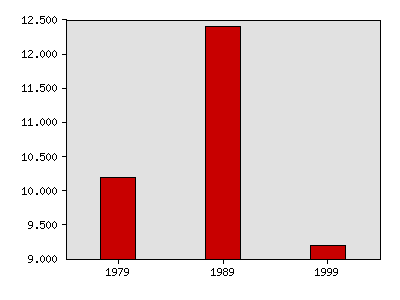What were things like in 2002?
The following idicator summary is from the 2002 Minnesota Milestones and does not neccessarily reflect the current data trends.Indicator : Child poverty
Rationale: Household poverty is the most direct indicator of the economic status of children.
About this indicator: This indicator reports the percentage of children under age 18 living in households below the federal poverty line. The percentage of children under 18 living in households below the federal poverty line rose from 10.2 percent in 1980 to 12.4 percent in 1989 but fell to 9.2 percent in 1999. The poverty line is a federal estimate of the pretax annual income needed to meet basic living costs, adjusted for family size. In 2000, the poverty level for a family of four was $17,603. Historically, poverty rates in Minnesota are highest among American Indian children, closely followed by African American families. Child poverty has also been considerably higher in Hispanic and Asian families than in non-Hispanic White families.
Percentage of children under age 18 in households below the federal poverty line

| Year | Data |
|---|---|
| Percentage of children under age 18 in households below the federal poverty line, U.S. Bureau of the Census | |
| 1979 | 10.2% |
| 1989 | 12.4% |
| 1999 | 9.2% |
For comparison: Nationally, in 1999, 16.1 percent of children under 18 lived in households below the federal poverty line. This is significantly above the Minnesota rate of 9.2 percent.
Things to think about: In 1999, the percentage of children living in poverty varied from county to county; Beltrami County and Mahnomen County were the highest at 21.7 percent and 21.3 percent respectively. Scott, Sherburne, Washington and Dakota Counties had the smallest rates, ranging from 3.4 percent to 3.9 percent. In the state's two most populous counties rates were higher in Ramsey County, at 15.7 percent, than in Hennepin County, at 10.45 percent. In the two counties overall, this represented 47,448 children.
Technical notes: The U.S. Department of Commerce adjusts the poverty level annually to reflect changes in the Consumer Price Index. Reliable state-level data is available only every 10 years from the U.S. Census. The Census Bureau produces annual estimates of poverty rates between census years, but the estimates are based on survey samples too small to provide dependable data for Minnesota. For reference, the 1998 estimate was that 12.6 percent of children in Minnesota live below the poverty line.
Sources:U.S. Bureau of the Census, Decennial Census, 1980, 1990 and 2000, www.census.gov.
Related 2002 Milestones indicator:
Other related indicators:
- Number of children (and rate per 1,000) receiving welfare through the Minnesota Family Investment Plan (Minnesota Department of Human Services, www.dhs.state.mn.us)
Local data:
County level data:





